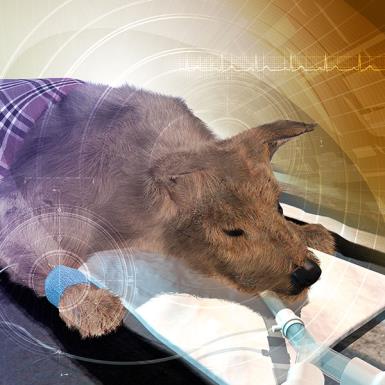Emergency patients present special challenges because their underlying disease processes can cause immediate, life-threatening problems that require rapid and aggressive intervention. Problems can arise from an acute illness, toxicity, or injury; from a chronic illness that has decompensated; or from an unexpected complication of a concurrent illness.
Emergency Medicine and Critical Care

-
Emergency Medicine Introduction
-
Evaluation and Initial Treatment of the Emergency Patient
-
Specific Diagnostics and Therapy
-
Fluid Therapy
-
Monitoring the Critically Ill Animal
- Overview of Monitoring for the Critically Ill Animal
-
- Fluid Balance:
- Oncotic Pull/Albumin:
- Glucose:
- Electrolytes and Acid-Base Balance:
- Oxygenation and Ventilation:
- Level of Consciousness/Mentation/Neurologic Status:
- Blood Pressure:
- Heart Rate, Rhythm, Contractility, and Myocardial Injury:
- Temperature:
- Coagulation:
- Red Blood Cell and Hemoglobin Concentration:
- Renal Function:
- Infection Identification/Prevention and Treatment and Immune Status:
- GI Motility and Mucosal Integrity:
- Drug Dosages and Metabolism:
- Nutrition:
- Pain Control:
- Nursing Care:
- Wound Care and Bandage Changes:
- Tender, Loving Care:
-
Ophthalmic Emergencies
- Overview of Ophthalmic Emergencies
- Traumatic Proptosis
- Traumatic Retrobulbar Hemorrhage
- Eyelid Lacerations
- Corneal Foreign Bodies
- Penetrating Intraocular Injuries
- Deep Stromal Corneal Ulcers, Descemetocele, and Iris Prolapse
- Corneal Lacerations
- Glaucoma
- Anterior Lens Luxation
- Anterior Uveitis
- Acute Vision Loss
- Optic Neuritis
- Sudden Acquired Retinal Degeneration (SARD)
- Retinal Detachment
-
Wound Management
-
Equine Emergency Medicine
Emergency Medicine and Critical Care Sections (A-Z)
Emergency Medicine Introduction
Emergency patients present special challenges because their underlying disease processes can cause immediate, life-threatening problems that require rapid and aggressive intervention. In addition, the full extent of the animal’s illness, injuries, or toxicity may not be evident for 24–48 hr or more after initial presentation. Problems can arise from an acute illness, toxicity, or injury; from a chronic illness that has decompensated; or from an unexpected complication of a concurrent illness. The status of all postoperative patients should be considered critical until life-threatening anesthetic or surgical complications are excluded. The golden rule of emergency medicine is to treat the most life-threatening problems first.
Equine Emergency Medicine
Equine emergencies can be challenging for veterinary practitioners and emotionally charged for owners. There is also the inherent possibility of injury to the owner and veterinarian because of the sheer size of the animal and the “fight or flight” reflexes of an injured horse. Problems can be reduced by educating owners about emergency preparedness and first aid procedures. The most common types of equine emergencies are abdominal pain (colic), trauma, lacerations, and acutely ill foals.
Evaluation and Initial Treatment of the Emergency Patient
Triage is the art of assigning priority to emergency patients and their problems based on rapid assessment of historical and physical parameters (see Table: Parameters to Evaluate During Triage). Several historical or observed problems warrant transfer of the animal to the treatment area regardless of physical findings. These problems include known or suspected trauma, poisonings, profuse vomiting or diarrhea, urethral obstruction, labored breathing, cardiopulmonary arrest, seizures, loss of consciousness, severe alterations in mental state, acute inability to walk, excessive bleeding, prolapsed organs, potential snake bite, heat prostration, open wounds exposing extensive soft tissue or bone, anemia, burns, dystocia, shock, and disease that may rapidly decompensate such as gastric dilatation and volvulus and allergic reactions.
Fluid Therapy
Cardiac function; intravascular volume; and vascular tone, integrity, and patency are critical to normal circulation. An abnormality in one or more of these components of circulation leads to stimulation of the sympathetic nervous system, which results in compensatory changes to maintain perfusion. The hemodynamic and cellular changes that develop as a result of these abnormalities are called shock. As shock progresses, oxygen and substrate delivery to the tissues becomes insufficient to meet energy requirements for cellular maintenance and repair. If shock progresses and cellular energy demands cannot be met, the ensuing organ failure leads to death. Early recognition of the type and stage of shock is vital to establishing a successful fluid therapy plan; timely intervention with appropriate therapy will prevent or decrease organ injury and/or death.
Monitoring the Critically Ill Animal
Anticipation, not reaction, is the key to successful management of critically ill animals. Animals must be effectively treated and actively monitored to detect or prevent organ compromise before organ failure occurs. This often requires aggressive and repeated fluid resuscitation and support throughout the course of definitive therapy.
Ophthalmic Emergencies
Specific Diagnostics and Therapy
Diagnostic and therapeutic efforts in emergency situations can be directed by the nature of the trauma. Blunt trauma is commonly associated with thoracic and abdominal bleeding, organ rupture, fractures, and neurologic injuries. Penetrating trauma is typically localized to the path of the penetrating object, which is rarely a straight line. Falling from a height causes long bone and facial bone fractures as well as thoracic and abdominal injuries. A dog bitten by a larger dog can have deep-penetrating bite wounds, spinal injuries, major abdominal and thoracic trauma (even without penetrating wounds), and tracheal rupture from the shearing forces sustained during thrashing motions. Resuscitation of the airway, breathing, and circulation; control of hemorrhage; and pain relief are followed by a careful evaluation of the nervous system, chest, abdomen, integument, and musculoskeletal system.
Wound Management
Wound healing is the restoration of the normal anatomic continuity to a disrupted area of tissue. An understanding of the normal process of wound healing is essential to make sound decisions in the management of wounds. Correctly using the principles of wound management helps avoid premature wound closure and its potential complications.
Also of Interest
Test your knowledge
Bradycardia in a cat, as evidenced by a heart rate <120 beats/min, is most likely associated with which of the following?




